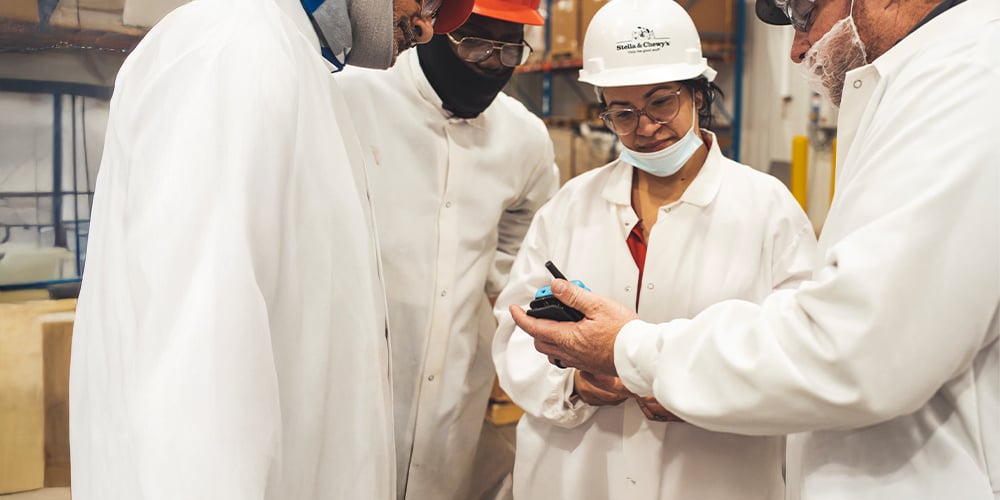There are so many challenges that food and beverage manufacturers face — complex operations, large factory floors, and the need for seamless communication between various departments. Choosing the best radios for the food and beverage industry requires careful consideration. Range, durability, and industry-specific capabilities are important in helping businesses scale into the next decade as technology hurdles forward with astounding speed.
Key Benefits of Technology in the Food and Beverage Industry
In the fast-paced food and beverage world, maintaining efficiency and safety while managing complex operations is no small feat. Advanced technology in the food and beverage industry has emerged as a critical component in helping businesses overcome workplace communication barriers, reduce downtime, and enhance productivity.
Let’s explore the key benefits of integrating technological food and beverage solutions:
1. Real-Time Communication
Regardless of the size of the facility or the number of team members involved, modern technology should ensure communication happens instantly, eliminating communication issues in food and beverage manufacturing.
Real-time updates let teams respond to issues like equipment malfunctions, supply shortages, and safety incidents as they happen. This helps halt disruptions and prevent small problems from escalating. Food and beverage radio solutions equipped with features like push-to-talk (PTT) communications and multimedia messaging are critical for facilitating instantaneous connections.
2. Staff Synchronization
Manufacturing has many departments — production, quality control, logistics, and maintenance — and they all must work in harmony. The best radios designed for the food and beverage industry should make seamless communication across these departments possible, ensuring everyone is on the same page. This synchronization reduces bottlenecks, eliminates redundancy, and enhances efficiency.
3. Increased Safety
Safety solutions are important to the food and beverage industry because mishaps can lead to serious consequences. Radios with mass alerts, muster tracking, and a man-down system enhance worker safety by giving immediate support during critical situations.
For example, team members should have the ability to report hazards or call for assistance without leaving their workstations, helping companies meet regulatory compliance while also safeguarding their employees.
4. Reduced Operational Costs
Advanced technology in the food and beverage industry significantly reduces operational expenses. By streamlining connections, communication solutions help businesses cut down on production delays, improve resource allocation, and reduce human error. Durable, feature-rich radios lower maintenance and replacement costs, offering a recurring, long-term ROI.
Keep reading: How to make the case for two-way radio systems

Top Radios for Food and Beverage Manufacturing
We’ve got to give you some examples, but we’ll keep it simple. Below, we evaluate the leading radios for food and beverage manufacturing and which might be the right choice for you:
1. Walt Smart Radio System
The Walt Smart Radio System is built for the unique demands of food and beverage manufacturing – its rugged design and advanced features are tailored to withstand the harsh environments of production floors while enabling reliable, instant communication.
Here's why Walt is at the top of the list of best radios for food and beverage factories:
|
Walt Smart Radio System by weavix |
|
|
Key Features |
|
|
Use Cases |
|
|
Advantages |
|
2. Motorola Two-Way Radios
Motorola is a longstanding name in communication tech, but its radios often rely on older, less adaptable systems. Even though some of its solutions are among the best radios for the food and beverage industry, advanced competitors such as Walt outperform them with superior technology, such as artificial intelligence, PT3, and speech-to-text.
Take a closer look at the characteristics of Motorola radios.
|
Motorola Two-Way Radios |
|
|
Key Features |
|
|
Use Cases |
|
|
Advantages |
|
|
Disadvantages |
Motorola’s traditional two-way radios lack the modern features businesses demand, such as real-time language translation, multimedia messaging, and integration with any kind of platform, which can create communication inefficiencies over time |
3. Relay
Relay promises simplicity and portability but falls short in robustness and feature set for demanding manufacturing environments. Let's explore its key features, use cases, advantages, and disadvantages.
|
Relay |
|
|
Key Features |
|
|
Use Cases |
|
|
Advantages |
|
|
Disadvantages |
Relay’s lack of a screen and platform support restricts its capabilities — its limited durability and lack of advanced safety features make it unable to fit the demands of food and beverage manufacturing |
4. Rapid Radios
Rapid Radios markets itself as a budget-friendly option, but the lower cost brings significant trade-offs in functionality and reliability. Here's a review of Rapid Radios' key characteristics.
|
Rapid Radios |
|
|
Key Features |
|
|
Use Cases |
|
|
Advantages |
|
|
Disadvantages |
This food processing plant walkie-talkie lacks advanced features like multimedia messaging and emergency alerts, and its range greatly limits its value in larger, more complex manufacturing operations — the costs of inefficiencies and breakdowns will eventually outweigh the perceived initial savings |
5. Zello
Zello is a push-to-talk app that turns smartphones into walkie-talkies. While it offers flexibility and accessibility, its reliance on personal devices can limit its effectiveness in the fast-paced food and beverage industry.
|
Zello |
|
|
Key Features |
|
|
Use Cases |
|
|
Advantages |
|
|
Disadvantages |
Zello relies on personal smartphones, which can create security and compliance concerns in regulated environments. Additionally, Zello lacks dedicated safety features and enterprise-grade durability, limiting its effectiveness in demanding manufacturing environments. |
Keep reading: Dive into 7 reasons why phones don’t work for the frontline
6. Beekeeper
Beekeeper is designed for enterprise-wide collaboration and frontline communication, offering a digital workplace platform rather than a traditional radio system. While it works for team messaging and information sharing, it lacks the real-time, instant voice communication critical for manufacturing floors.
|
Beekeeper |
|
|
Key Features |
|
|
Use Cases |
|
|
Advantages |
|
|
Disadvantages |
Beekeeper is not designed for real-time, hands-free communication, making it less effective for production floor teams. It lacks push-to-talk functionality and instant voice response. It also requires workers to engage with a mobile app, which may slow operations on the frontline. |
Implement the Best Food and Beverage Solutions with weavix
 Among the options above, and every other food and beverage technology available on the market, the Walt Smart Radio System stands out as the ultimate solution because of its innovative features — such as AI-powered language translation, multimedia messaging, and emergency safety tools. The best part is that it addresses the industry’s specific needs while completely eliminating the limitations of other radios.
Among the options above, and every other food and beverage technology available on the market, the Walt Smart Radio System stands out as the ultimate solution because of its innovative features — such as AI-powered language translation, multimedia messaging, and emergency safety tools. The best part is that it addresses the industry’s specific needs while completely eliminating the limitations of other radios.
For those wanting to reduce downtime, boost worker safety, and completely streamline operations, weavix gives you more than just the right smart radio — it provides a comprehensive platform for worker connection. Adopting the best radios for the food and beverage industry gives your team the tools they need to be their best.
Explore how weavix can transform your operations — contact us today and schedule a demo.
Subscribe
Don’t miss out on industry news and information. Subscribe to interweave, the official weavix™ blog today.


